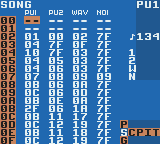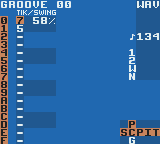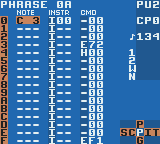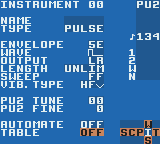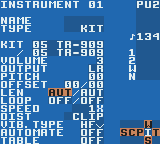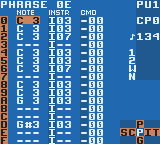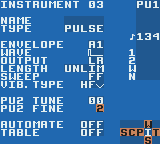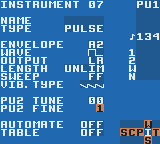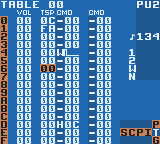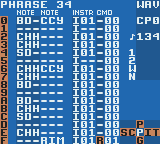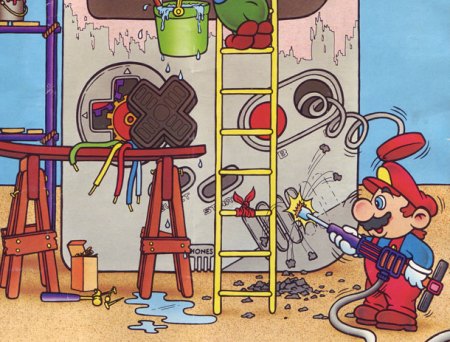An actual circuit bent Gameboy (?) and some Lego
June 28th, 2007I’m actively checking my search engine referrers, so I know what people were looking for when they got here. I’ll do also do a more complete post about this, Syd Lexia style.
One of the more popular keywords for people finding their way here, are Gameboy circuit bending. (And related terms) This is what I believe to be the first actual circuit bent Gameboy I’ve come across. (Found by accident on youtube) I’m not totally sure if the guts are actually from a Gameboy though.
This might also be of interest: A bent Casio SK-8 with a breakout box made of a GB case. Done by the pro-bender Kaseo.
And also another little thing I found by accident: A Gameboy built in Lego. (Although it looks like a prop, it looks damn nice)

Found at Brickshelf.
Death Note 37 - the end of it all
June 28th, 2007Death Note has come to an end, and I managed to find a fansub this time too. I’m planning to post a few rants about DN37 and the series as a whole, but for now I’ll refrain from doing that, so I won’t spoil anything. (I’ll post my rants in a week or so)
Today’s fansub comes from Ruberia, and can be download through bittorrent here: Death Note 37
Now I’m downloading Appleseed, which I meant to see ages ago. I’m also waiting eagerly for Dennou Coil 06.
Google XSS vulnerability
June 28th, 2007I found these two blog posts today. What an irony!
http://googleblog.blogspot.com/2007/06/more-organizing-tools.html
http://ha.ckers.org/blog/20070617/another-google-xss-in-google-documents/
More musical Tesla coils (And a musical saw)
June 24th, 2007Since my last post, I’ve discovered that itseems like there quite a few musical Tesla coil videos on youtube. This is probably due to the eeeeeevil works of The Geek Group.
I’ve picked three of my favourite videos.
This one is a comprehensive explanation to the inner workings of a musical Tesla coil. As it seems their version takes an audio signal, reduces it to one bit in depth and sends it as a modulated carrier signal to the coil.
Well, I’d like to see some other signal formats to see if it can change the audio quality. I can think of at least two ways:
- You could send the signal as a PCM at the coils resonating frequency. (Same frequency, different pulse width)
- You could create a PCM at a lower frequency than the resonating frequency and then modulate the resonating frequency by that PCM
- Another idea that I personally find compelling is that you could ring modulate the carrier by the input signal and power the coil with the result. That would be interesting!
(Three items? I told you I could think of at least two ways)
I like the tune he’s playing in this one, and also the snap that every new note makes, gives the sound a sense of dynamics.
Another one from The Geek Group, the Tetris theme again, this time polyphonically played by two coils.
From one rare sound source to another: I recently found a digitalization of a rare vinyl recording from 1963, given out as an encouragement to the salespeople of Sandvik. Apart from a short speech in both Swedish and English to the salespeople, there are threee songs by Moses Josiah, played on a musical saw. Which is simply a saw held like a violin and played. It’s not a hard metallic sound, but rather a soft resonant sound, which reminds of that of a theremin. (Which is of course part of the reason I decided to blog about it)
Watch out for the next post, having fun with search engines.
Death Note 36
June 22nd, 2007
I haven’t really blogged about animé yet, but I thought now was a good time. In case you haven’t heard the news: Viz has recently licensed Death Note in USA, and they’ve also sent C&D’s to various fansub groups, including Kuro-Hana and Animanda, meaning that they won’t (officially) be subbing Death Note episodes 36 and 37. (In the case of Animanda, a few more episodes as well, since they focus more on quality checking than KH and take longer to get the releases out)
So, knowing that DN36 was probably out by now, and eager to watch it, I looked at The Pirate Bay and to my surprise and joy I found three results. Two releases by a group called C&D (A reference to Viz’ letters sent to the subgroups subbing Death Note) and one by a group called Ben-KoR (Never heard of)
As it turned out, the release by Ben-KoR, and the one labeled v2 wre both fake. Instead they contained a documentary about the 9/11 attacks. /:
These two releases also had funny checksums in their torrent name. (Containing non-hex characters) My little conspiracy theory is that it’s Viz that uploaded these torrents to spoil the fun. If it had been some malicious teenager, the checksum would’ve looked ok, (Only hexes) and the file would’ve been a hardcore porn movie to rape people’s eyes and brains. ^_^
So, I’ll quit my yabbbering and give you the working link: Death Note 36.
My opoinions about the episode? It’s by far the best episode so far, but I won’t tell myuch about what happens in it, to avoid spoiling. I can tell you this much: This is the episode when Light and Near will finally meet, and it ends in a real cliffhanger. (What else is to expect when there’s only one episode left?)
Also I’ll take this opportunity to say that I’ve updated my site a little with a list of animés I’m watching. Check it out.
Alternative speakers made of flames, Tesla coils, fans and air!
June 20th, 2007Did you think that a speaker must consist of a vibrating membrane? Wrong! There are various other methods of creating sound. All it takes is something that makes the air vibrate. Or rather strictly speaking, anything that makes your eardrum vibrate. It’s possible to create an audible sound by vibrating the skullbone, and in turn the eardrum and the rest of your ear’s hearing mechanisms. Such headphones do exist and are being sold primarily to swimmers.
But even on land there are various more or less weird ways of making the air vibrate. The reason I decided to finally write this post is because of a cool link that Tiago (xernobyl) sent me. And with or without his knowledge, I’m a sucker for Tesla coils.
It’s a video of a speaker consisting of a Tesla coil. Tesla coils are generally used to produce high voltages that create sparks in the air, mad scientist style. A tesla coil should be feeded with an AC current in order for it to do its job, and this guy came up with the idea of modulating the carrier frequency to produce sound.
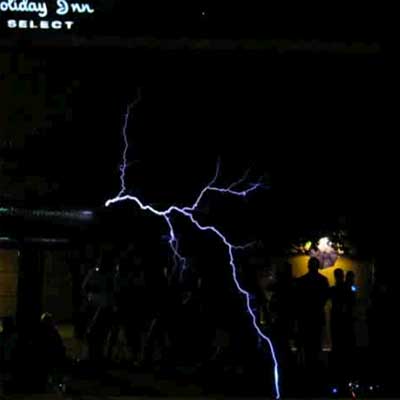
(Click the image to see the video)
It seems like the sound has a bit-depth of 1-bit, making it ideal for chiptunes, and sure enough in the video showcase he played both music from Super Mario Bros (The underground theme) and Gameboy Tetris Type A music. There was also a first tune in the video that I don’t recognize. If you readers have a suggestion, tell me.
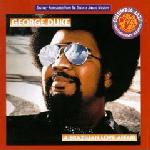 As a side note. The Super Mario Bros underground music seems to be very much inspired by a riff from George Duke’s 1979 record Brazilian Love Affair (From the first song, which shares its name with the album) I haven’t listened through the whole album for more possible sources of inspiration for Koji Kondo.
As a side note. The Super Mario Bros underground music seems to be very much inspired by a riff from George Duke’s 1979 record Brazilian Love Affair (From the first song, which shares its name with the album) I haven’t listened through the whole album for more possible sources of inspiration for Koji Kondo.
However… I’d like to have on of these! I’d hook it up with MIDI or something and make it a full fledged synth. One of the first things that I’d try to do is to add polyphony. Since the modulation in question is probably only a simple PCM, I’d try to increase the virtual bit depth, so to speak. Two or four square waves isn’t too much to ask for, right?
The Tesla coil link also reminded me of another thing I’ve been planning to post for some time. I’ve found a 1970 magazine about technology, and one article caught my attention. It was about one of those crazy inventions that never left the drawing board because for reason or other.
What I found was an article about a so called flame speaker. In some weird way it uses a speaker to amplify a sound. The scanned article is in Swedish, but Google has (at least) two more useful links, with scans from English magazines from the time.
http://www.swtpc.com/mholley/PopularElectronics/May1968/Flame_Amplification.htm
http://www.4×4pride.org/Flame/Docs/FlameAmp/FlameAmp.html
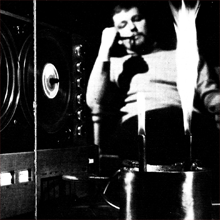
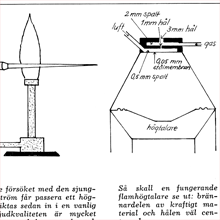
Click images for full article scans (in Swedish)
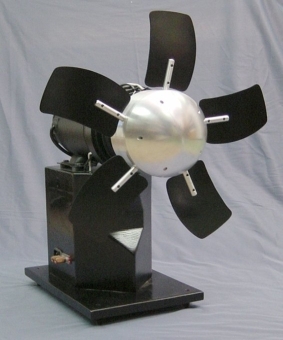 I’d like to build a flame amplifier/speaker at some point. But a fair guess is that the bass response is pretty bad. What to do about that? Just go buy a sub woofer?
I’d like to build a flame amplifier/speaker at some point. But a fair guess is that the bass response is pretty bad. What to do about that? Just go buy a sub woofer?
Not me! I’d complete it with a Rotary Woofer. In simple terms you could say that this is a fan that pushes the air back and forth, and so creating the sound.
So for the last onconventional type of speaker. It’s called a bumbimagi… No it isn’t, RastaMahn, STFU and get a life. It’s the directional type of speaker. It works not by producing any audible sound itself. Instead it produces a beam of ultrasound, which is inaudible to humans. (But is audible and even painful for dogs, and can still damage human ears, but that’s another story) The ultrasound then gets distorted in the air which produces audible frequencies.
The effect is similar to what happens when you play two notes on an instrument with a certain interval. (I don’t remember which interval now) the tones create a subharmonic. This is a technique used primarily by xylophonists. In a more controlled form the effect can, as mentioned, be used to create directed sound. The sound audible to humans is only audible within the pillar of air, defined by the direction of the speaker.
The product is being sold by the company HoloSonics, and they also have a little more information on the technology.
This post also comes with a couple of bonuses, things that I happened to find or do during the research for the post.
Here are some more scans from the Swedish 1970 magazine with article about flame amplification. (Flamhögtalare in Swedish)
The magazine is called “Tekniken idag” (Technology Today) which seems to be a special issue of “Tekniskt magasin” (The Technology Magazine)
Cover (Omslag)
The Computer, quickwitted, but dumb, spread 1 (Datamaskinen, snabbtänkt men dum, uppslag 1) - An article from back then about computers.
The Computer, quickwitted, but dumb, spread 2 (Datamaskinen, snabbtänkt men dum, uppslag 2) - Contains an image of a 1970 light pen and big big memory grid from the same year.
“Elmar” has the first artificial brain (”Elmar” har den första konstgjorda hjärnan) - An article about father of today’s robotic vacuum cleaners. However, “Elmar” is very stupid, it only uses one photocell to back off it comes to close to something… And that’s all it does, I think.
There are also a few more retrospective articles about astronomy, satellite spionage, supraconduction, the Loch Ness monster, PCMI microfilm, Hikari, (ひかり, the world’s fastest train at the time) an article about the future of television, (Amazingly mentioning flat TV’s) a test of a car PA, an article about Jules Vernes, and a collection of articles about space, which was the theme of the issue in question. There were also a few articles about cars and motor cycles that I didn’t find interesting enough to mention. (And whose contents are probably outdated, even from a retrospective point of view)
I can scan any of the articles mentioned, at request.
The other bonus is an album containing the complete sound track of Super Mario World, played on (mostly) acoustic instruments. Normally I tend to think that video game covers on traditional instruments tend to sound like shit, but this guy manages to do it in a proper way. The album has a professional touch to it, kind of like how Nintendo would do it to paraphrase the classic game in one of their newer titles.
So, check it out.
The source lsdsong file for camvliez
June 19th, 2007After two specific requests to release this song (From skrebbel and Bud Melvin) and one general plead for more open sav’s from neutral_insomniac, I decided to finally release the source file for Camvliez. (Click the name to see the original post where you can also listen to the tune as an MP3)
Click here for the LSDSong source for the tune
This post should also be seen as a sort of LSDj tutorial, and if you find it useful, please don’t hesitate to leave a comment or link to the post.
If you’re a beginner, who don’t know how to get started with LSDj, please do check out this comprehensive tutorial by starpause and this one by
nullsleep.
Here are some advice and facts that might be useful:
- The song is composed with Little Sound Dj v 3.1.9 and should ideally be played back with the same version to avoid incompatibilities. (However, I don’t see much in this one that could wrong on other versions)
- When I first uploaded the file to my PC, I got a weird bug in chains like 05 and 06 (Where ever there were C commands) where the sound changed properties when the pointer reached the end of a phrase, and the note was still playing. I found out that this bug was caused by some sort of “shadow notes” on the step 0 in the phrase. B+A (LSDj command for cut/delete) on that position reset the note and made the bug go away.
- Camvliez is really an unfinished song, and some time I will finish it for real. (Some people including myself think that it ends to abruptly) But, there also a hidden unfinished tune in there. I got some ideas while looking through the sav a last time, so I just put them there. If anyone wants to finish remix that, please do so!
- Use the clone command! By first copying a chain or phrase to a new position, and then pressing select+{B, A} (Hold select while pressing B then A) This is my usual method of applying small variations to songs made in LSDj.
- The MP3 version of the song was recorded on a cheap-o soundcard from redledboy, using a regular audio cable. (No fancy 192 kHz, 32-bit fireqire audiocard here…) The sound was touched up in Audacity using the builtin bass boost, then Audacity’s compressor with its default settings, then I gave the file a boost at maybe 4-7 kHz (Don’t remember) It could sound better, but to me it’s acceptable.
Overview of the song.
I’m using a 7/5 groove, aka shuffle, which in effect means that the first note in a phrase is a little longer than usual, and the next one is a little shorter, next one is longer, next one is shorter, etc. This gives a shufffle effect similar to the one the TR and TB series of machines by Roland.
My advice to people using grooves is to keep the sum of the groove 12. (Or 24 if using two groups etc) If you don’t, the BPM will be inaccurate, and song will be harder to sync to each other over link cable.
This is a phrase that uses so called “pattern break”, meaning that when you reach the H00 command, the phrase will end after 4 steps, which I use for a short break thing with a rising square wave.
There we have the said rising square wave. Look at the envelope parameter. 5 is the starting volume, and E is the fade direction, E means “rise slowly”.
As you can see it has no name, which is a bad habit of mine. You should name them.
Here we have the main drum instrument. Not much to say about it. It uses the 909 kit for both its software channels. Apart from that nothing is changed from the default settings.
And again, name your instruments boys and girls!
Here’s my bassline. Bud Melvin asked about it, so here the trick. Instrument 03 is 1/8 (12.5%) pulse width square wave to give some crisp to the sound, and 07 is a 1/2 (50%) wave with a tod longer decay. This gives what according to me is a pretty nice bass line.
Also please note the vibrato setting. It’s not HF as usual, but a regular vibrato type. This affects not only vibrato, but also makes legato and pitch slide (L and P commands) slower. This allows me to do a nice lick thing with the instrument. (Check out song position 31, chain 29, phrase 42, phrase positions A-B) The PFF/P01 combo makes the pitch first go down a little, then back up again.
I actually got a ompliment on that effect, that’s why I decided to mention it. I never thought anyone would notice, but it seems like it pays off to add small details to your music.
This is a table that makes a pretty nice effect. (Used in instrument 08) 0C on the first step quickly rises the tone one octave over the played note, FA lowers it 6 semi-tones below the played note. (I actually meant it to be lowered 7 semis, making end up at the subdominant of the played note, but it sounds good this way too)
A few ticks later, I change the wave form from 1/4 (25%, as set in the instrument) to 1/8. (12.5%) This adds to the snappy character of the sound.
The H (hop) command means something else in tables than it does in phrases. As shown before, it makes a pattern break in a phrase. In a table, the H command hops within the table instead. The rightmost digit defines the target position, the leftmost one defines the number of times the loop should loop. (0=Infinitely) The H0C command here simply catches the cursor in an infinite loop, so that it won’t apply the snap effect continually.
Here are some kit drums played on the WAV channel. I’ve put a lot of work in to gradual progression in the drums, which hopefully makes the music more interesting. (As mentioned above, use the clone command!) Also, it’s worth noticing the R (Retrig) command. It gives a quick drum roll there at the end. (But you might need to watch out if you place an empty phrase after it, since the retrig continues)
As said before, if you find this info useful, please leave a comment. ![]()
24769ism
June 15th, 2007Time to puzzle you people. Nobody will eveeeer understand the meaning of this picture. Bort bort bort!
Another glimpse from my childhood (:
June 12th, 2007Here’s another little memory from my childhood that I thought I’d never see again. It’s an ad that shows how a Gameboy supposedly looks inside. It also goes well with theme of this page. Knowing what I know now, I’d say they were a bit wrong though. (:
Source: kreese.com
nitro2k01 on the OXO001 Compilation
June 11th, 2007As some of you might know I’m affiliated with OXO Unlimited, a small music label run by friends. The main theme of the album is breakcore and related styles, but I managed to sneak some chip music in there, in the shape of Recall168. (Hehe)
You can listen to a preview of the song on my myspace page (archive.org).
Here’s an album teaser if you’re interested in what else is on the CD:
![You suck at protoshop. No, you [i]really[/i] oo.](http://blog.gg8.se/images/you-suck-at-photoshop-you-really-do-your-awful.png)



